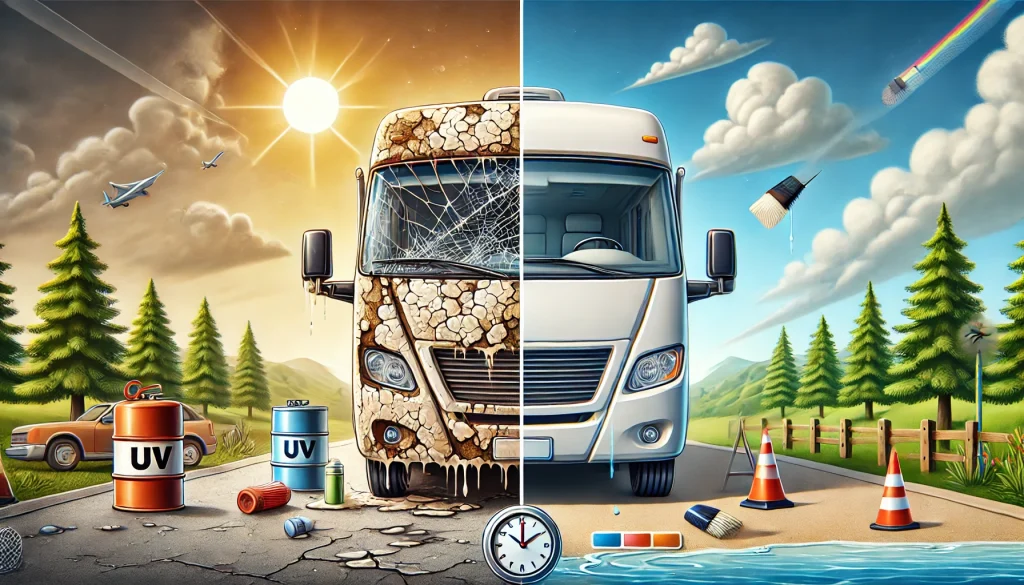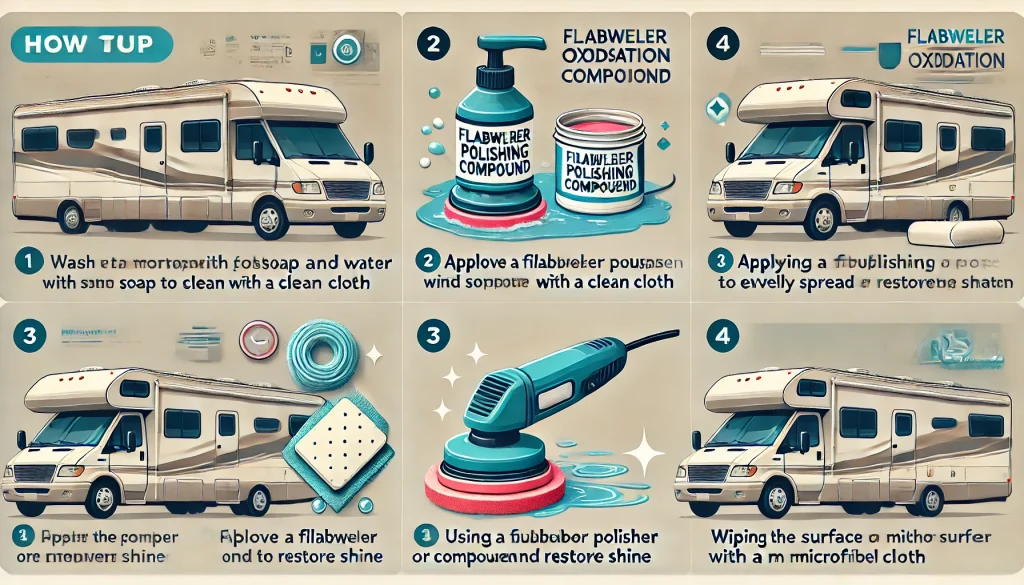Fiberglass oxidation on your motorhome can dull its shine and ruin its appeal. Luckily, restoring that glossy finish is easier than you might think! This guide will walk you through simple, effective steps to remove fiberglass oxidation from your motorhome. If you’re wondering how to remove fiberglass oxidation from your motorhome, this guide has you covered. We’ll walk you through simple, effective steps to restore your motorhome’s glossy finish and protect it for years to come!

What Causes Fiberglass Oxidation?
Fiberglass surfaces are coated with a gel coat to provide shine and protection. Over time, UV rays, dirt, and environmental exposure break down this layer, leaving a chalky, faded appearance.
Why and When Should You Remove Fiberglass Oxidation?
Maintaining your motorhome’s appearance and durability requires addressing oxidation promptly. Here’s why and when to act.
Why Remove Fiberglass Oxidation?
- Restore the Shine and Aesthetics
Oxidation causes a chalky, dull appearance. Removing it restores the glossy finish, making your motorhome look like new. - Prevent Further Damage
Untreated oxidation can weaken the gel coat, leading to:- UV damage
- Cracks
- Moisture intrusion
- Increase Resale Value
A shiny, oxidation-free exterior enhances your motorhome’s resale value. - Enhance Durability
Applying wax or sealant after oxidation removal protects against harmful elements like UV rays and rain.

When Should You Remove Oxidation?
- Visible Signs of Fading or Chalkiness
If the surface looks dull or leaves white residue when touched, it’s time to act. - After Long Sun Exposure
Regular exposure to UV rays accelerates oxidation. - Before Applying Protective Wax
Remove oxidation to ensure wax adheres properly. - During Annual Maintenance
Incorporate oxidation removal into your yearly routine for easier upkeep.
Tools and Equipment for Removing Fiberglass Oxidation
Using the right tools ensures efficiency and professional results. Here’s what you’ll need:
Cleaning Equipment
- Bucket and RV-Safe Soap: Removes dirt and grime.
- Soft-Bristle Brush or Sponge: Cleans without scratching.
- Microfiber Cloths: For drying and preventing water spots.
Polishing Tools
- Dual-Action Polisher (DA Polisher): Buffs evenly for efficient oxidation removal.
- Polishing Pads: Foam for mild oxidation; wool for severe cases.
- Handheld Applicators: Ideal for detailed areas.
Oxidation Removal Products
- Fiberglass Oxidation Remover: Tailored for RV surfaces.
- Rubbing Compound: For severe oxidation.
Finishing Tools
- Microfiber Towels: Buffs off products for a glossy finish.
- RV Wax or Gel Coat Sealant: Protects against UV rays and dirt.

Step-by-Step Guide to Removing Fiberglass Oxidation
1. Gather Materials
Prepare all necessary tools, including oxidation remover, polisher, and microfiber cloths.
2. Clean Thoroughly
Wash the motorhome with RV-safe soap, rinse, and dry completely.
3. Apply Oxidation Remover
- Apply in sections using a polisher or handheld pad.
- Use circular motions to lift oxidation.
- For severe cases, repeat the process or use a rubbing compound.
4. Buff and Shine
Buff treated areas with a polisher or microfiber cloth for a smooth finish.
5. Protect with Wax or Sealant
Seal the surface with a UV-resistant wax for long-lasting protection.

Preventing Fiberglass Oxidation
- Regular Cleaning: Wash monthly to remove contaminants.
- Apply UV Protectant: Use wax or gel coat sealant after washing.
- Store in Shade: Minimize UV exposure with a cover or shaded parking.
Class-Specific Methods for Motorhomes
Class A (Large Motorhomes)
- Use a dual-action polisher for large areas.
- Divide into sections for systematic cleaning.
Class B (Compact Motorhomes)
- Focus on intricate areas with handheld polishing pads.
Class C (Mid-Size Motorhomes)
- Use a step ladder for over-cab areas exposed to UV rays.

Common Mistakes to Avoid
Following are the common mistakes
1. Skipping Cleaning
Always clean before applying oxidation remover to prevent scratches.
2. Using the Wrong Products
Use only fiberglass-specific products and test on a small area first.
3. Overusing a Buffer
Apply light pressure and move steadily to avoid damage.
4. Neglecting to Seal
Seal with wax after removal to prevent re-oxidation.
By following these steps and tips, you can effectively remove fiberglass oxidation, restore your motorhome’s shine, and protect it for years to come. Regular maintenance and the right tools are the keys to keeping your motorhome looking as good as new!

More details related to this article will be on Flamingo Motorhomes

